
Hickory, oak, apple, mesquite, pecan, walnut, maple, cherry, and alder are among the best woods for smoking meat and seafood, each offering a distinct flavor suitable for different types of meat and fish.
Strong, bold woods like hickory and mesquite suit red meats, while sweeter woods like apple and cherry are great for meat and seafood. Woods like oak are versatile for various meats, and alder is ideal for seafood, providing a light flavor.
As an experienced barbecue enthusiast, I’ve learned through extensive trial and error, and hours of research about smoking woods. Believe me when I say that the type of wood you choose can make or break your BBQ, so you want to get it right.
Continue reading to discover the flavor profiles of different smoking woods, ideal pairings with different meats, the woods to avoid, and the best choices for any BBQ situation.
Jump to:
- 1 At a Glance Table of Smoking Woods, Flavor Profiles, and Meat Pairings
- 2 Which Woods Go Best With Which Meats?
- 3 What Do the Most Popular Smoking Woods Taste Like?
- 3.1 Alder: The Seafood Specialist
- 3.2 Apple: A Fruit Wood Favorite
- 3.3 Ash: A Light, Unique Flavor Enhancer
- 3.4 Beech: A Subtle, Versatile Smoking Wood
- 3.5 Birch: Delicately Sweet, Good for Poultry
- 3.6 Cedar: Intense Aroma, Only Good for Planking
- 3.7 Cherry: A Subtle, Sweet-Smoky Flavor
- 3.8 Chestnut: Mild and Slightly Nutty
- 3.9 Hickory: The Classic Choice for Smoking
- 3.10 Maple: A Mild, Sweet Choice
- 3.11 Mesquite: The Bold Choice for Smoking
- 3.12 Oak: A Versatile Smoking Wood
- 3.13 Pecan: A Nutty Flavor Profile
- 3.14 Walnut: A Strong, Distinctive Option
- 4 Can Any Wood Be Used for Smoking?
- 5 Can You Mix Smoking Woods?
- 6 Debunking the Myth of Matching Wood with Meat
- 7 My Advice
At a Glance Table of Smoking Woods, Flavor Profiles, and Meat Pairings
| Wood | Flavor Profile | Food Pairings |
|---|---|---|
| Alder | Mild and light — Delicate, subtle, slightly sweet, musky. | Fish (particularly salmon), poultry, and light-meat game birds. |
| Apple | Mild to Medium — Light and sweet, slightly fruity. Can be mixed with other woods for great results. | Poultry, beef, pork, (particularly ham), lamb, game birds, and cheese. |
| Ash | Mild — Light, unique flavor. | Poultry, fish and seafood, beef, pork, lamb, game, and game birds. |
| Beech | Mild — Well-balanced, good all-rounder. Can pair with stronger woods to make less overpowering. | Poultry, fish and seafood, beef, pork, lamb, game, game birds, and cheese. |
| Birch | Mild — Clean and not overpowering. Similar to maple. Remove the bark, which is oily and strong. | Poultry, fish and seafood, and pork. |
| Cedar | Medium — Sweet and tangy. Big, bold flavor, but not strong and overpowering. | Only ever really used for 'planked' fish (particularly salmon.) |
| Cherry | Medium — Subtle, sweet and fruity, to mildly tart. Gives a rosy red tint to meats. Great mixed with oak and apple. | Poultry, fish and seafood, beef, pork, lamb, game, and game birds. |
| Chestnut | Mild — Nutty and slightly sweet, a little tangy. | Poultry, fish and seafood, pork, and cheese. |
| Hickory | Strong — Bold, universal flavor. Sweet and strong. Bacony flavor. Can be pungent. Can be overpowering, good to mix with oak. | Poultry, beef, pork, game, game birds, cheese. Most popular with pork, ribs, and bacon. |
| Maple | Mild — Somewhat sweet, subtle, balanced flavor. | Poultry, fish and seafood, pork, and cheese. |
| Mesquite | Very strong — Strongest of all. Earthy and spicy. Use sparingly. | Beef, pork, and poultry. |
| Oak | Medium — Traditional rustic flavor. Stronger than apple and cherry, lighter than hickory and mesquite. Bold but not overpowering. | Poultry, fish and seafood, beef, pork, lamb, game, game birds, and cheese. |
| Olive | Mild — Similar flavor to mesquite, but very light in comparison. | Best with poultry. |
| Orange | Mild — Light and fruity, tangy and citrusy. Lighter than most other fruit woods. | Poultry, fish and seafood, and pork. |
| Peach | Medium — Sweet and earthy Similar to hickory, but sweeter, fruity and milder. | Poultry and pork. |
| Pear | Medium — Light and sweet, slightly fruity, very similar to apple but lighter. | Poultry and pork. |
| Pecan | Strong — Similar to hickory, not as strong. Sweet and nutty. A good all-purpose, all-rounder. | Poultry, beef, pork, and cheese. |
| Plum | Medium — Sweet, bold, fruity flavor. | Poultry, fish and seafood, and pork. |
| Walnut | Strong — Heavy flavor, can be bitter. Good mixed with sweeter fruit woods. | Beef, pork, and game. |
Which Woods Go Best With Which Meats?
There are widely accepted pairings of smoking woods and meats that bring the best results, so I thought it would be good to add a brief summary of those here as a quick reference.
Best Wood for Smoking Beef (Particularly Brisket)

Beef is an intensely flavored, dark red meat that benefits from and can stand up to a good hit of medium to strong smoke. Especially brisket!
I’ve discussed this topic in-depth in my article on the best woods for smoking brisket, so you can check that article for a more complete discussion. But here are the top 7 choices at a glance:
- Hickory
- Oak
- Mesquite
- Cherry
- Apple
- Maple
- Pecan
Best Wood for Smoking Ribs

As discussed in our article to the best woods for smoking ribs, If like me, you like a strong, pronounced smoky flavor on your BBQ ribs, these woods should be your top choices:
- Hickory
- Oak
- Pecan
- Mesquite
However, if you like the smoky flavor dialed down a little, these should be your top choices:
- Maple
- Apple
- Cherry
- Peach
Best Wood for Smoking Pork

Pork really is the meat that pairs well with any kind of smoke from any of the acceptable smoking woods. So it comes down to your personal taste.
Generally speaking, though, the best woods to use are sweeter ones from fruit trees, such as:
- Apple
- Pear
- Peach
- Orange
But if you like a more pronounced smoky flavor, pork also stands up well to bolder smoke from woods such as:
- Hickory
- Maple
- Pecan
- Mesquite (in small doses!)
Best Wood for Smoking Chicken

Chicken is somewhat delicate and easy to overpower with some of the stronger wood smokes. So avoid intensely smoky hardwoods that you would use on beef, like mesquite, oak, or walnut.
Try these woods for a mild, complementary flavor:
- Hickory
- Maple
- Apple
- Cherry
- Peach
- Pecan
Check out our article on the best woods for smoking chicken for a deeper discussion.
Best Wood for Smoking Turkey

Here are our favorite picks for a delicious smoked turkey that has just enough smokiness to please while still allowing room for sauces, spices, and natural turkey taste.
- Maple
- Cherry
- Pecan
- Apple
- Alder
Although keeping your smoke light is the best option for turkey, some people like it heavier. Here are a couple of woods to consider if you want your fowl to have a more smokey flavor.
- Mesquite
- Oak
Check out our guide to the best woods for smoking turnkey for a more detailed discussion on the topic.
Best Wood for Smoking Fish and Seafood
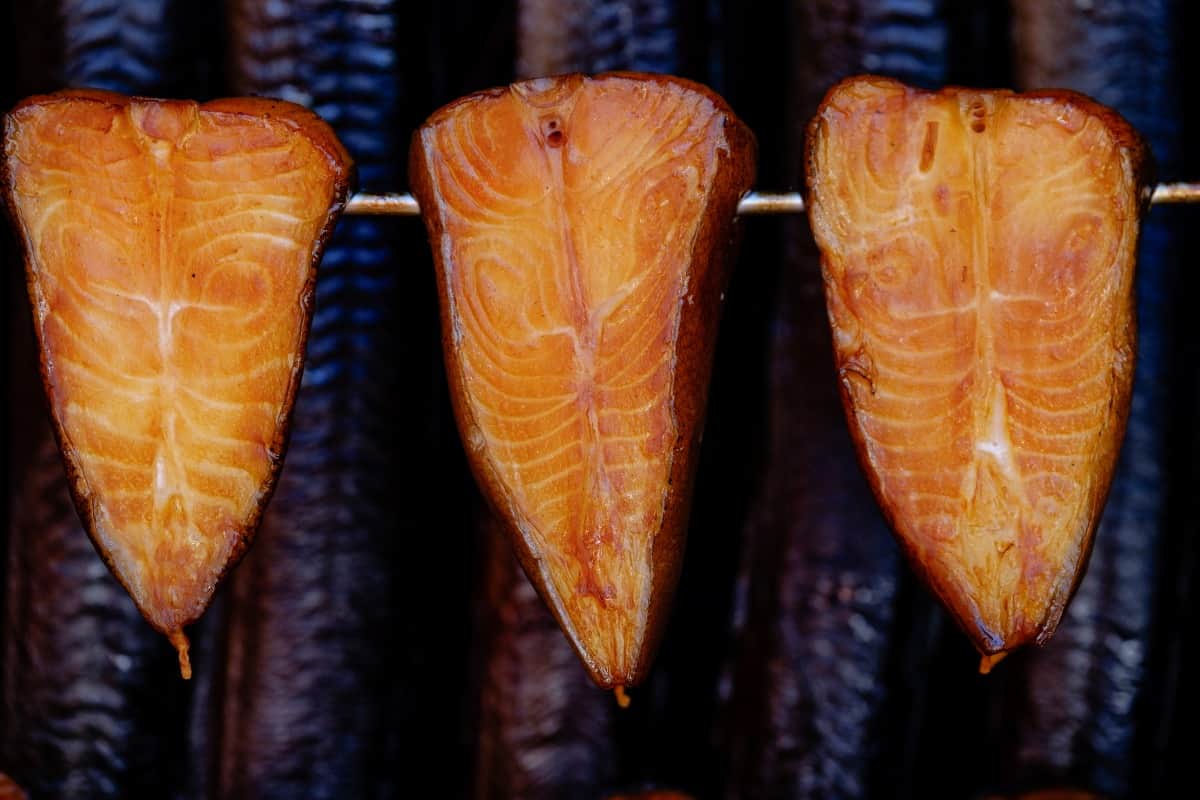
For smoking fish and seafood, alder stands alone as the very best. It is mild, well-balanced, not at all overpowering, and lends a great smoky overtone while allowing delicate fish flavors to shine through.
Other mild-flavored wood smokes that suit well are:
- Apple
- Ash
- Beech
- Birch
- Maple
- Orange
Though if you want a real kick of smoke on your fish, still without totally overpowering it, the following bolder smoke flavors go well:
- Cedar (particularly for salmon)
- Cherry (though it will discolor skin and flesh slightly red)
- Hickory (use sparingly, though, as it’s potent!)
- Oak
- Plum
What Do the Most Popular Smoking Woods Taste Like?
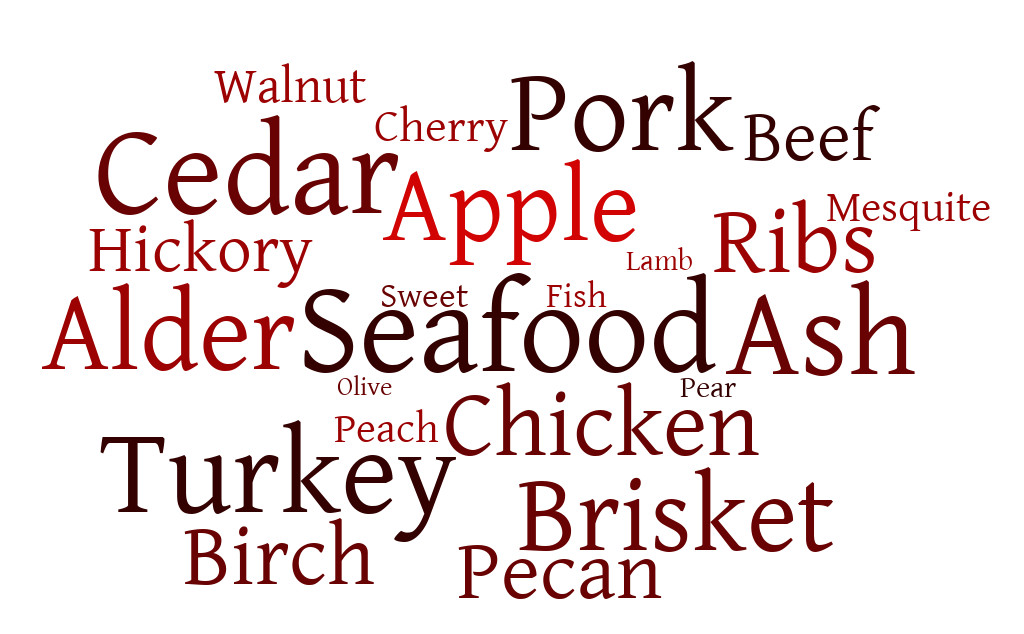
In alphabetical order, the most popular woods for smoking are alder, apple, ash, beech, birch, cedar, cherry, chestnut, hickory, maple, mesquite, oak, pecan, and walnut.
Let’s take a look at each in turn, to discuss their general flavor profile and uses.
Alder: The Seafood Specialist

Alder wood is great for smoking delicately flavored foods because it has a light and slightly sweet taste. It doesn’t overpower your food with a strong smoke flavor. Because it’s so light, alder is really popular for smoking fish, especially salmon.
Alder is also good for other seafood, shellfish, chicken, and light meats.
People like using alder because it adds a gentle smoky touch without changing the food’s natural flavors too much. It’s perfect for those who enjoy a milder smoke taste in their BBQ.
I never use alder for anything besides fish because for me the flavor is just too mild. After decades of BBQ I’ve built up somewhat of a tolerance and although I hate to see meats flavor masked, alder is just too mild. So do keep in mind if you want a pronounced smoky flavor, this may not be the right wood for you.
Apple: A Fruit Wood Favorite

Apple wood is favored for its sweet, fruity taste, with a mild to medium strength smoke profile. Its flavor adds a gentle sweetness and mild smokiness making it perfect for white meats, enhancing their taste. Apple wood works well with meats like pork, poultry, game, ribs, and wildfowl.
Besides meats, apple wood also complements milder fish and cheeses, adding a sweet touch. However, it can overpower poultry if used too much.
Mixing it with woods like oak or cherry can help round out and balance the flavors for even better results. Apple and oak, or apple and cherry are two mixes I use often when smoking pork butts and shoulders.
Ash: A Light, Unique Flavor Enhancer
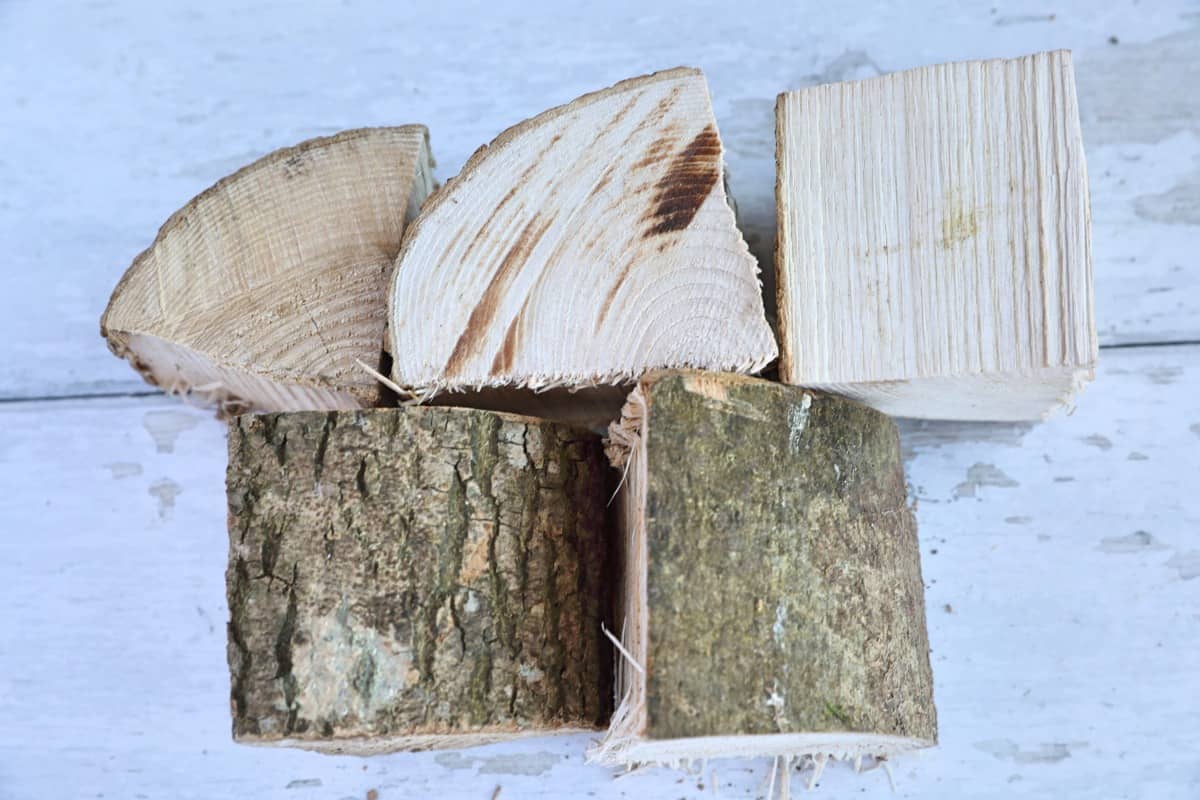
Ash wood is a good choice if you only want a mild yet unique flavor, perfect if you’re the type who sometimes finds smoked food too heavy.
The light taste of ash makes it versatile and well suited for many kinds of food. You can use ash wood for smoking poultry, fish, seafood, beef, pork, lamb, game, and game birds. Almost anything really.
Its mildness won’t ever overpower your food, it will add a special, light smoky taste that is still an enhancement, however mild it may be
Beech: A Subtle, Versatile Smoking Wood

Beech offers a mild and well-balanced flavor. It’s a good all-rounder, meaning it works with lots of different foods.
You can use beech wood for smoking poultry, fish, seafood, beef, pork, lamb, game, game birds, and even cheese.
Its mildness makes it great for blending with stronger woods such as oak, hickory, or pecan, creating a less overpowering smoke flavor overall.
Beech wood is ideal for adding a gentle, balanced smoky taste to a wide variety of BBQ dishes.
Birch: Delicately Sweet, Good for Poultry
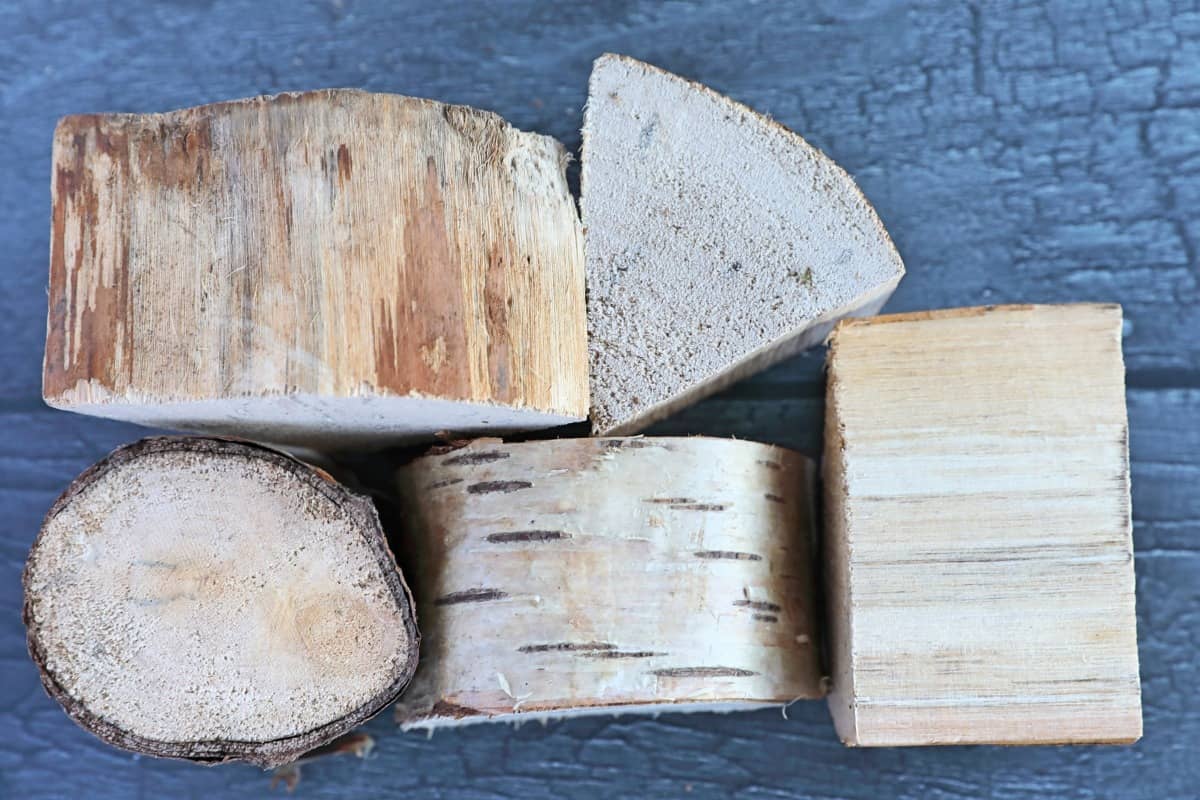
Birch wood doesn’t get a lot of love in the BBQ community as a smoking wood, which I feel is a shame because it’s readily available, and has a mild and well-balanced flavor. It’s a good choice for many types of food, making it quite versatile.
Birch wood is often described as having a clean and mild flavor, similar to maple. It’s not overpowering, making it great for foods like poultry, fish, seafood, and pork. In my experience it’s too mild to be used for beef, you should use something stronger.
Note that it’s important to remove the bark from birch wood before using it for smoking, as the bark can be oily and add a strong not overly pleasant taste. It also burns very fast so you may want to use more than you initially think, or top up slightly more often.
Birch is actually one of my most used smoking and firepit woods, but that’s probably because it’s so abundant and I regularly get it very cheap.
Cedar: Intense Aroma, Only Good for Planking

Cedar wood, with its medium strength, provides a sweet and tangy flavor that is pronounced yet not overwhelming. In my experience it’s solely ever used for ‘planked’ fish, notably salmon, as opposed to being used for general smoking.
Cedar’s limited use in smoking stems from its potential toxicity when burned and the fumes inhaled. This risk makes it unsuitable for traditional smoking techniques. However, when used for planking the cedar plank serves as a shield between the fish and the heat, smokes only gently, and allows for the safe infusion of the wood’s distinctive taste into the food while protecting the delicate fish from the flames below.
Cherry: A Subtle, Sweet-Smoky Flavor

Cherry wood, known for its subtle, sweet, and slightly smoky flavor, complements a variety of meats such as poultry, pork, beef, fish, and turkey, offering a unique taste that enhances the overall grilling experience.
Besides flavor, cherry wood also imparts a reddish hue to the meat, adding visual appeal. Due to its mildness and the color it adds to foods, it’s a favorite for mixing with stronger woods like oak, hickory or pecan.

Cherry wood is often expensive to buy compared to other woods, and it also burns quickly, so I add a chunk or two into the mix with other woods rather than smoke with cherry on its own.
Chestnut: Mild and Slightly Nutty

Chestnut wood offers a mild, nutty, and slightly sweet taste with a hint of tanginess, making it an excellent choice for smoking a range of foods. It pairs wonderfully with poultry, fish and seafood, pork, and even cheese, adding a unique flavor that elevates these dishes.
Chestnut’s gentle flavor profile doesn’t overpower the natural taste of the food, instead, it subtly enhances it, making it ideal for those who prefer a less intense smokiness.
Hickory: The Classic Choice for Smoking

Hickory wood is famous for its bold flavor that’s both strong and sweet, with a bacon-like taste. It can be quite strong and sometimes too much, which is why it’s often mixed with oak to make the flavor more balanced.
Hickory is great for smoking many foods, including poultry, beef, pork, game, game birds, and cheese. It’s especially good with pork, ribs, and bacon. The combination of sweet and strong flavors from hickory enhances these meats, making it a favorite for many.
When using hickory, keep in mind its strong flavor, especially if you prefer a lighter taste. Mixing it with oak softens its strength, making it more suitable for a variety of meats and dishes.
Maple: A Mild, Sweet Choice

Maple wood has a mild, sweet, and subtly balanced flavor. It’s great for poultry and pork, and can also add a nice touch to smoked vegetables and cheese.
Its density is a plus, allowing it to burn slowly and provide a steady smoke for an extended time compared to other woods, which is perfect for long smoking sessions.
I often mix maple with apple wood to smoke pork, and it’s always a big hit. The maple’s sweetness and apple’s light fruitiness create a complex, tasty flavor.
Maple’s smoke is not as intense as other woods, so if you want a stronger taste, try mixing it with apple or cherry wood to bring more depth to your smoky BBQ flavors.
Mesquite: The Bold Choice for Smoking

Mesquite wood is known for its very strong, earthy, and spicy flavor, making it the strongest of all smoking woods. It’s best used sparingly and is excellent for smoking beef, pork, and poultry due to its bold taste.
Mesquite burns hot and fast, which suits shorter cooking times and works well with hearty meats like beef brisket and pork ribs that can handle its intensity.
Often associated with Texas-style BBQ, mesquite is crucial for achieving the region’s signature robust flavors. However, it’s tricky to use right; too much can make the meat taste harsh. It’s essential to use mesquite with care and know-how.
Mesquite is pretty much the only time I have managed to over-smoke anything! I used it with some beef ribs once and my wife said it tasted like an ashtray! Great news! Even I found it harsh, so she wasn’t wrong. So be warned, use it sparingly.
Oak: A Versatile Smoking Wood

Oak wood offers a medium, traditional rustic flavor that’s bolder than apple and cherry but not as heavy as hickory or mesquite. It’s basically an all-rounder and is perfect for a wide variety of foods, including poultry, fish, seafood, beef, pork, lamb, game, game birds, and even cheese.
Its mild and slightly sweet smoke complements without overpowering, enhancing the natural flavors of the meat.
I use oak probably more than any other wood because it’s readily available, has a wonderful flavor and gives nice long slow burn.
Pecan: A Nutty Flavor Profile
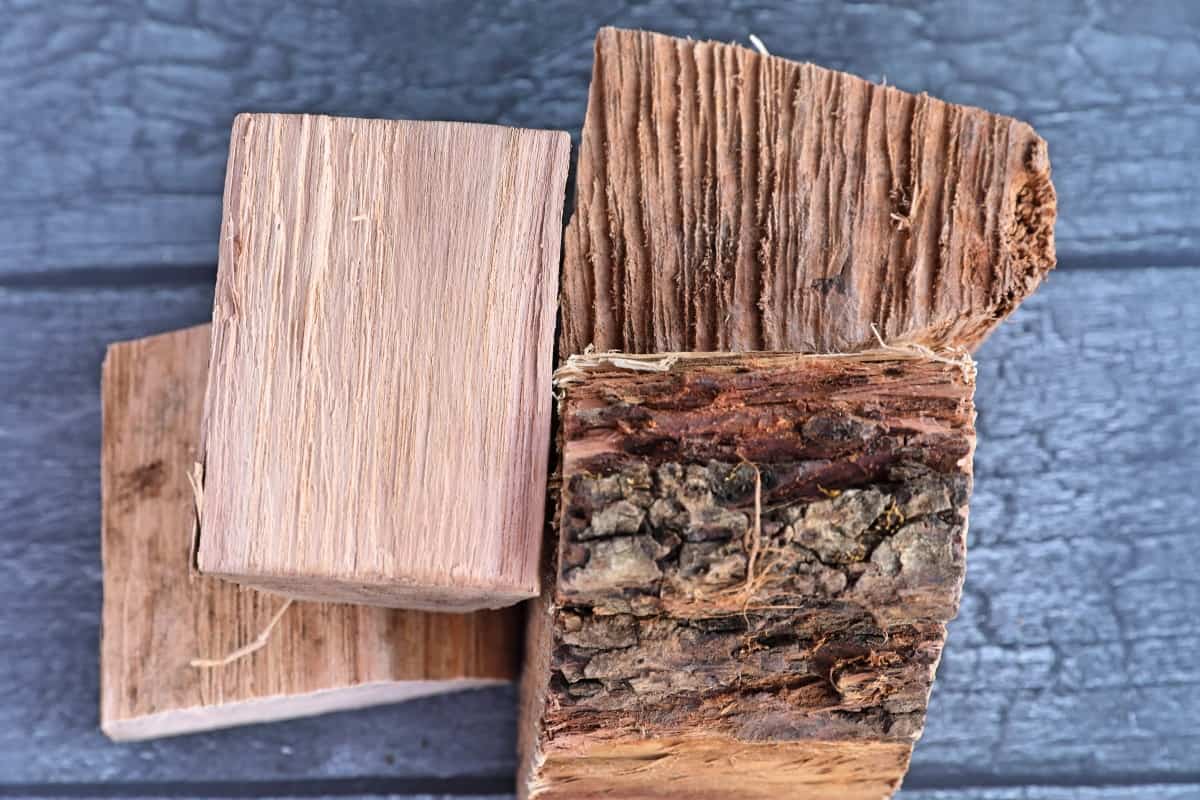
Pecan wood, part of the hickory family, is a favorite for its sweet, nutty flavor that’s strong but not as intense as hickory. It’s an all-purpose wood that goes well with poultry, beef, pork, and cheese.
When smoked with pecan, meats take on a unique, slightly sweet taste that enhances their natural flavors. But you do need to be careful as as its taste is strong and you can overpower delicate white meats. For this reason, I always only use a little and preferably mix it half and half with oak or cherry.
Walnut: A Strong, Distinctive Option

Walnut wood is strong and can give a heavy, sometimes bitter flavor, which is why it’s good to mix with sweeter fruit woods. It’s best for smoking beef, pork, and game because of its rich, nutty taste.
When I first used walnut for a beef brisket, it added a memorable richness. However, too much can be bitter, as I found some beef ribs I smoked with walnut years ago. To prevent it from being too strong, use half the amount you wood with oak or apple since its potent flavor really will overpower milder foods.
Can Any Wood Be Used for Smoking?
No, not any wood can be used for smoking. Certain types can ruin your food by imparting acrid flavors, while others are toxic or contain irritants, posing health risks.
Woods to avoid include:
Aspen, cypress, eastern cedar, elderberry, elm, eucalyptus, fir, hemlock, laburnum, liquidambar, locust, mangrove, oleander, pine, poisonous walnut, redwood, spruce, sycamore, tamarack, tambootie, and yew.
You must also avoid smoking with any of these woods:
- Woods treated with preservatives.
- Woods possibly treated with herbicides, pesticides, or fungicides.
- Painted, stained, or varnished woods.
- Scaffold boards or pallets, potentially chemically treated or exposed to unknown substances.
- Woods showing rot, mold, or fungus, as burning them releases toxins.
- Woods contaminated with poison ivy or similar, emitting irritating vapors when burned.
- Woods with unusual odors, which can transfer to food.
- Unknown wood species, as the risk is too high.
Can You Mix Smoking Woods?

You can mix smoking woods for unique flavor combinations not possible with a single wood type.
Mixing strong, earthy woods with lighter, sweet-fruity woods creates a balanced, complex flavor profile, combining the best of both.
Popular combinations include apple with oak, hickory, or pecan for a complex, earthy, spicy, sweet, and fruity smoke.
Another common mix is cherry with oak, hickory, or pecan for a full range of flavors and a red tint to meats from the cherry smoke. I go through A LOT of cherry because I love the color it gives to meat, and it balances out stronger woods I pair it with.
Before experimenting with mixing, I recommend smoking with only single species at first to get used to what they taste like. But then, go wild. Smoke is an ingredient, so have a play with it.
Debunking the Myth of Matching Wood with Meat
Here I come with a controversial statement, but it’s one that many agree with!
After all I’ve read, experienced, and tested, my thoughts on wood smoke flavors and food pairings are that smoke from different woods certainly taste differently and can be more suited to different foods. However, it’s my opinion that many people go obsessively overboard, exaggerating the difference that different wood smokes make. They try to get so specific and granular in their pairings that it makes no sense.
There are very strong wood smokes that can completely overpower chicken, fish, and veg, and hence should not be used with these foods. There are wood smokes at the other end of the scale so mild that they do not stand up well to a rubbed roast of beef where a more robust smoke pairs much better.
But let me ask you something:
After you take a piece of beef, pork, or chicken, perhaps marinade, inject or brine it, then rub it in a blend of salt, pepper, herbs, and spices, then smoke it for hours, and finally apply a sauce before eating with sides, can you really determine subtle differences in the flavor of the wood smoke used? In my opinion, no.
After the layers of flavor we apply to our BBQ, can you really tell the difference between meat smoked with ash, beech, or maple? Between meat smoked with apple or pear? I certainly cannot, and nor can any of the dozens of people I have cooked for either — I have done such tests on people.
My Advice
Here are the key differences I like to keep in mind when choosing my wood smoke flavors:
- Fruit woods: Mild, sweet smoke.
- Nut woods and solid-seeded trees: Stronger smoky flavor.
- Mesquite: Very strong, earthy, spicy smoke. Best used in small amounts and mixed with lighter woods.
- Oak, hickory, and pecan: Versatile, providing a medium to strong smoky flavor.
- Apple and cherry: Mild smoky flavor, suitable for many dishes.
- Cherry: Adds a pleasing red color to smoked meats.
My advice is to start with two types of wood: one mild and one medium to strong, based on local availability.
For mild flavor, use any fruit wood, like apple. For a stronger flavor, choose oak, hickory, or pecan, whichever is easiest to find and affordable.
Start with one wood from each category. Use them until you’re comfortable with the smoky flavor they add to your dishes. Once you’re familiar with these woods, you can try experimenting with others.
Don’t go crazy buying 11 types of wood, the benefits to such variety are minimal, if there’s any benefit at all. The best woods for smoking are the ones you can source easily and cheaply. One mild, one medium to strong. That’s all you need.


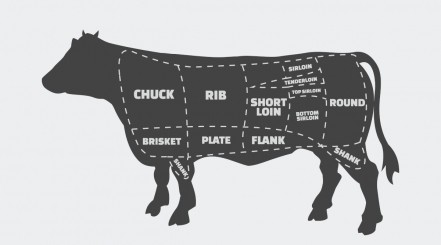



0 Comments